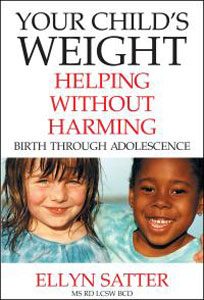Child "overweight" and "obesity"
From birth, follow the Satter Division of Responsibility in FeedingAddress your child’s weight with the Satter Division of Responsibility in Feeding
The Ellyn Satter Institute position is that the terms overweight and obesity (BMIs in excess of the 85th and 95th percentiles, respectively) are not useful when applied to individual children. Many children grow naturally and consistently at or above those percentiles and are perfectly healthy. From the ESI perspective, a child’s weight only becomes a concern when it accelerates: Weight abruptly goes up across a number of growth percentiles.
Support your child’s growth whether naturally large, small, on in-between, from birth, by following the Satter Division of Responsibility (sDOR) in Feeding: You do the what, when, and where of feeding, let your child do the how much and whether of eating, and let her grow in the way that is right for her. Address weight acceleration (or deceleration) by following sDOR and letting your child’s natural ability with food regulation restore eating and growth that is right for her.
On the surface, the intervention is simple enough – so simple, in fact, that you may feel you are doing nothing at all. In reality, you do a tremendous amount when you follow sDOR and thereby do good parenting with feeding. You keep up the day-in-day-out of family meals and structured snacks throughout your child’s growing-up years. Then you keep your nerve and trust your child to eat as much or little as she needs and grow in the way that is right for her.
Following sDOR is rewarding, consistent with maintaining a nutritious, health-promoting, and moderate diet, and supports the quality of your family life. As a consequence, you will be able to keep up the considerable effort of maintaining pleasant and rewarding family meals and sit-down snacks. Then you can forget about strategies for getting your child to lose weight:
- You don’t have to try to control what and how much your child eats . . . and you don’t have to try to get her to control it, either. She will naturally eat as much as she needs.
- You don’t have to try to get her to eat more “healthy” foods such as fruits and vegetables, whole grains, and other low-fat foods. She will naturally learn to eat and enjoy them when you eat and enjoy them.
- You don’t have to be the food police with so-called “unhealthy” foods – the high-fat, high-sugar stuff. Including them regularly at meals and snacks takes the “special” out of them and allows eating them in moderation.
- You don’t have to give up Friday night pizza nights or movie popcorn or hide tempting foods so your child doesn’t get them. Your child will be relaxed and matter-of-fact about eating all foods.
More about addressing children's weight
- Big baby, big parents: No problem!
- Child overweight: are current guidelines helpful? Do they do harm?
- Children who are obsessed with food
- Doctors and weight: Helping without harming
- Managing “junk” food AKA sweet, chips, sodas
- Trouble-shooting with the division of responsibility
- Vegetable agenda: Getting children to eat “nutritious” food
Consider ESI coaching
ESI's expert advisors can help you, step-by-step, properly apply sDOR as well as remain consistent and firm while your child’s eating attitudes and behaviors ever-so-gradually improve.

Learn to follow the Satter Division of Responsibility in Feeding
On the right are resources to help you learn how to feed based on the Satter Division of Responsibility in Feeding (sDOR). Read Your Child’s Weight: Helping without Harming and watch the feeding videos to get a clear understanding of good feeding based on sDOR. Observe how children naturally behave with eating. Be considerate without catering in your meal-planning. Each meal needs high- and low-calorie foods as well as one or two foods your child generally eats. Then adjust your expectations of your child. When you apply sDOR, your goal is not to limit him to a certain amount food or get him to eat certain foods or avoid others. It is for him to feel good about eating and eat much or little depending how hungry he is. And be prepared for the long haul. He will only feel good about eating, eat the amount he needs, and grow consistently when you accurately apply sDOR and continue to follow it.
Evidence that your child eats the amount she needs
If you have been restricting your child, it will take him a while to recover his trust that you will let him eat as much as he wants. It will also take him a while to become sensitive to his own feelings of hunger and fullness. At first, he is likely to eat a lot, especially of foods you haven’t let him eat before. But after a few weeks or months, depending on his age, he will begin to show evidence of his ability to regulate her food intake. He will:
- Feel good about eating
- Come willingly to meals and snacks and behave appropriately there
- Do most of his eating at regular meal-and snack-times
- Be relaxed about getting enough to eat
- Be relaxed about eating all kinds of food
- Come to meals and snacks hungry and eat until he is satisfied
- Manage how much he eats without worrying whether it is too much or too little
- Grow at a consistent percentile or shift gradually up or down
For help with raising your big child or your small child to feel good about himself and have the body that is right for him, read Ellyn Satter's Your Child’s Weight: Helping Without Harming
To see what good feeding looks like as well as to read about it, see Ellyn Satter’s Feeding with Love and Good Sense DVD II.

For the home use version, click here.
Make an informed choice: sDOR or conventional treatment?
You are likely to be advised to follow some sort of restrictive diet with your child to try to get her weight down. Your adviser may even tell you to follow the division of responsibility in feeding along with the other methods listed below, but that is just wrong. You can not both follow sDOR and try to get your child to eat certain amounts and/or types of food. sDOR means letting your child determine for him/herself what and how much to eat from what you offer. Trying both follow sDOR and get your child to eat certain amounts or types of food will hopelessly confuse both you and your child. However, the choice is yours.
People who advise restricting children’s eating to slim them down seem to think that children who get “too fat” simply eat too much of the wrong food or move too little. For them, the solution is simple: get the child to eat less or move more. Those folks are unimpressed by the many, many studies demonstrating that child weight loss programs, in the home or at school, simply do not work.
Below are common conventional methods of child weight management. Even if such a method is called non-diet, or non-restrictive, or a point system, it is still a diet.
- Having a target or cutoff point for the child’s BMI (Body Mass Index): Defining the child as overweight if BMI is above the 85th percentile, obese if BMI is above the 95th, and trying to get the child’s weight to level off or go down.
- Emphasizing what and/or how much the child should eat: Trying to get the child to eat more low-calorie foods such as vegetables, fruits, skim milk, low-fat protein foods, and whole grains. Imposing portion sizes.
- Emphasizing what and/or how much the child shouldn’t eat: Trying to get the child to eat fewer high-fat, high-sugar foods such as sweets and fried food.
- Emphasizing exercise for the purpose of slimming. Giving the child guidelines or activities that emphasize how or how long to move.
- Targeting interventions toward the child: Giving the child (rather than the parents) instruction in food selection or prescriptions for activity. (Child-focused weight reduction interventions are particularly ineffective.)
- Miscellaneous: Giving calorie prescriptions, limiting eating out (particularly at fast-food restaurants), encouraging eating breakfast for the purpose of weight management.

